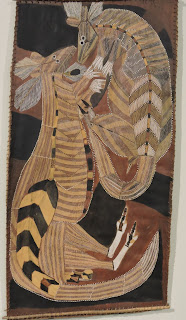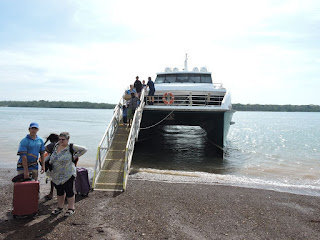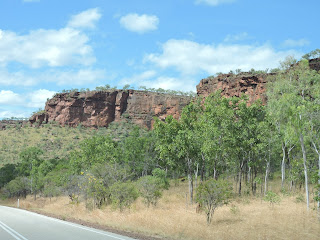We left Darwin on Friday 24 June and soon after leaving the town we turned off the Stuart Hwy to the Arnhem Hwy towards Kakadu National Park. In 2012 we spent a week in the Kakadu(http://ph-kr-aus-adventure.blogspot.com.au/2012/06/kakadu-national-park.html), visiting most of the main attractions, but passed through another smaller and less famous region, the Mary River National Park. The park has several unconnected sections, our destination today was Couzens Camp, a free camp site along the river. The turn-off to the park was only about 150 kms from Darwin, then about 20 kms to the North, still on sealed road, followed by about 15 kms of gravel in very good conditions.
We arrived around mid-day, in high heat. We drove around the camp, which was completely empty and dusty, not very attractive. We were not sure if we wanted to stay here. The only reason we wanted to come here was a wetland cruise operated by the Point Stuart Wilderness Lodge that was supposed to start from the nearby Rockhole. In 2012 we went on a similar cruise on the Yellow Waters in Kakadu NP, which we enjoyed so much, we wanted to have another go. We drove up to the Rockhole, where we found the boats and a phone number on a sign, but nobody around. It seemed quite a crazy idea to leave a phone number in the middle of nowhere, but to my surprise, there was phone reception. We found out that there will be a cruise starting at 4pm, so we decided to stay.
Back at the camp ground, we set up our van in the shadiest spot, but even there it was very hot, 34-35 degrees inside the van. We had lunch inside because it was impossible to stay outside because of the flies and the dust. It was about 2 hours not very comfortable wait before we returned to the boat ramp, where we found the tour guide and a few other people and started the 2-hour cruise.
But it was worth the wait. The Mary river stops flowing during the dry season, leaving large sections of wetland and as these gradually shrink in size, all the animals and birds concentrate at the remaining areas. One of them is the Rockhole Billabong, about a 7-km permanent section of the river. We have seen an amazing concentration of wildlife, at least 20-25 large saltwater crocodiles, some as close as a few metres only from the boat. Plenty of birds, egrets, darters, a huge sea eagle, jabiru, whistling ducks etc. The tropical vegetation on and around the water was also wonderful, water lilies, lotus lilies, groups of pandanus palms, paperbark forests. Our guide has explained all the details and got the boat frighteningly close to some of the big crocs - but they did not care about us. Sometimes he stopped the engines and we could listen to the birds in the silence (apart from the chit-chatting of two little children in the boat...) The cruise was officially for 2 hours, but our guide made a bit of overtime with us, to show us the evening lights and the sunset on the river. It was a truly amazing experience, perhaps even better than the Yellow Waters.
The slide-show below shows a selection of what we saw on the cruise. Although we selected the best pictures, it is always a disappointment to see how little they can reflect from the reality we had seen with our own eyes...
Back at Couzens Camp, we celebrated our 40th wedding anniversary with a bottle of champagne. What cannot be seen from the picture is the zillions of tiny flying insects that we were unable to keep outside the van in the heat (still 32 degrees in the evening) which was terribly annoying. But despite all these discomforts, this was a very memorable afternoon and evening, fit for such an important event.
Slideshow:
(If you can't see the slideshow from here, try this link
Június 24-én pénteken indultunk tovább Darwin-ból, és a várost elhagyva hamarosan elfordultunk a Stuart Highway-ről az Arnhem Highway-re a Kakadu Nemzeti park felé. 2012-ben eltöltöttünk egy hetet a Kakadu NP-ben (http://ph-kr-aus-adventure.blogspot.com.au/2012/06/kakadu-national-park.html), végigjártuk az összes fő látványosságot, de nem álltunk meg a kisebb és kevésbé híres Mary River Nemzeti Parkban. Ez a park több önálló részből áll, most mi a Couzens Camp nevű szabad táborhelyre tartottunk a Mary folyó partján. A lejárat a parkhoz csak 150 km-re van Darwintól, aztán kb 20 km burkolt út észak felé, majd még 15 km földút nyugat felé, ezúttal nagyon jó állapotban.
Déltájban érkeztünk meg és nagyon meleg volt. Körüljártuk a táborhelyet, sehol egy lélek, nagy por mindenütt. Nem látszott túl csalogatónak, gondolkodtunk hogy itt maradjunk-e. Amiért ide akartunk jönni, az egy hajótúra volt a Mary folyó lápvilágán, amit a Point Stuart Wilderness Lodge üzemeltet, és a közeli Rockhole nevű helyről indul. 2012-ben voltunk egy hasonló hajótúrán a Yellow Waters-nél a Kakadu NP-ben, amit nagyon élveztünk, azt szerettük volna megismételni. Felmentünk a Rockhole-hoz, megtaláltuk a hajókat, és egy táblát egy telefonszámmal, de itt sem volt senki. Elég furcsa ötletnek tűnt egy telefonszámot hagyni az Isten háta mögött, de meglepetésünkre kiderült hogy van vétel, és megtudtuk, hogy a következő hajótőra délután 4-kor indul - úgyhogy elhatároztuk hogy maradunk.
Visszamentünk a Couzens Camp-hez, tábort ütöttünk a legárnyékosabb helyen, de itt is nagyon meleg volt, 34-35 fok a lakókocsiban. Muszáj volt bent ebédelni, lehetetlen volt kintmaradni a por és a legyek miatt. Egy elég kellemetlen 2 óra várakozás után mentünk vissza a hajókikötőhöz, ahol már ott volt a túravezető és még egy pár utitárs.
De a túra megérte a várakozást. A Mary folyó a száraz évszakban leapad és nem folyik, de hosszú szakaszai megmaradnak állandó vízfelületként körülöttük elöntött mocsár és lápvilág. Ahogy csökken a vízszint az állatok és madarak a megmaradó felületek körül koncentrálódnak. Az egyik ilyen állandó vízfelület ez a Rockhole Billabong (aboriginal szó amit átvett az ausztrál angol, állandó vízfelületet jelent), egy kb 7 km hosszú folyószakasz. Bámulatra méltó állat- és madár-sokaságot láttunk a hajóút folyamán, legalább 20-25 nagy sósvizi krokodilt, többet egész közelről, alig pár métrenyire a hajótól. Rengeteg kölönféle vízi- és ragadozó madarat. A trópusi növényzet is fantasztikus a vízen és körülötte, vízi-liliomok, lótusz, pandanusz pálmák, eukaliptuszok. A túravezető sok érdekes részletet mondott el, és igyekezett egész közel menni a parton pihenő krokodilokhoz. Néha leállította a motort, hallgattuk a madárhangokat a csendben (leszámítva két kisgyerek zsivajgását a hajóban...) Hivatalosan két órás túra volt, de a vezetőnk túlórázott velünk egy kicsit hogy a naplementét is láthassuk a folyó felett. Csodálatos élmény volt, talán még jobb, tartalmasabb, mint a Yellow Waters-nél.
A csatolt album mutat egy válogatást abból amit láttunk. Igyekeztünk a legjobb képeket kiválogatni, de ujra nézve mindig csalódás, hogy milyen keveset tudnak visszaadni a képek abból amit valóban láttunk... (Ha nem látszik az album innen, próbáld meg ezt a linket!)
A táborhlyre visszaérve a lakókocsiban egy üveg pezsgővel ünnepeltük a negyvenedik házassági évfordulónkat. Ami nem látszik a képen az a kismillió repkedő kis rovar amiket képtelenek voltunk kirekeszteni a lakókocsiból a hőségben (még mindig 32 fok volt este is), ezeket elég nehéz volt elviselni. De minden kellemetlenség ellenére ez egy nagyon emlékezetes délután és este volt, méltó ehhez a fontos alkalomhoz.





































































